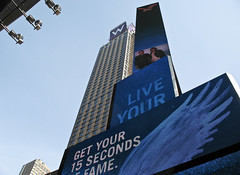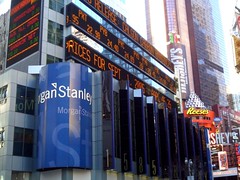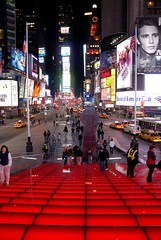South:Corner (760 8th Ave): From 2011 until 2020, this was the location of the famous Copacabana nightclub, which was the setting and namesake of a 1947 Groucho Marx/Carmen Miranda movie, and a 1978 Barry Manilow song. It's featured in several films, including Goodfellas, where it was accurately portrayed as a Mob hangout; the club was launched with Frank Costello as a silent partner, and was run for many years by Joe Gallo. This was the fourth location of the club, moving here from 34th Street. The opening act here was salsa star Willie Colon. The Copa is now located on 51st Street. 268: China Club 266: The Mean Fiddler, Irish sports bar. Was Stella's, one of the last places to see go-go boys in Times Square. Downstairs is The Woo Woo, a punk-themed bar that includes a sex shop for old school Times Square flavor. Brooks Atkinson Theater256-262: A Herbert J. Krapp design in the "modern Spanish" style for the Chanin Organization, completed in 1926; the ornamentation is by Roman Meltzer, formerly architect to Czar Nicholas II. Originally named for the 19th Century actor Richard Mansfield, it was renamed in 1960 for the theater critic. 250: Pierre au Tunnel, pre-theater French Hotel Edison228: The 9th floor of this historic hotel was home to George Burns and Gracie Allen after the marriage in 1927; their friend Jack Benny also lived here, on the 4th floor. Ring Lardner lived in Room 1935 for part of 1933. Moss Hart lived in a tower apartment in 1931 after his Once in a Lifetime was a Broadway hit. The hotel is featured in the films The Godfather and Bullets Over Broadway. The cafe here is noted for its Magic Table, where professional magicians gather to mystify one another. W New York-Times Square
Corner (1567 Broadway): This luxury hotel opened in 2001 featuring "almost hallucinatory public spaces" (Access NYC). Includes the Whiskey bar and the restaurant Blue Fin. Planet Hollywood had threatened to build a hotel here. |
W
|
North:Biltmore Theatre261-265: Another Chanin house
completed in 1926; the interior is by Krapp.
Barefoot in the Park and Hair
had long runs here.
Barrymore Theatre243-251: A 1928 Krapp design,
noted for its "wondrous ironmongery" supporting the
marquee. It was named for Ethel Barrymore,
the Shuberts' star performer, who appeared in
four shows here in its first four years.
Marlon Brando played here in
A Streetcar Named Desire, Fred Astaire
in The Gay Divorce, Sydney Poitier in Raisin
in the Sun; it was also the venue for
Clare Boothe's The Women.
Morgan Stanley
1585 (block): The post-modern facade of this building features rolling financial quotes. In 1914, this block became the site of The Strand, the first Times Square theater designed specifically for movies. |



